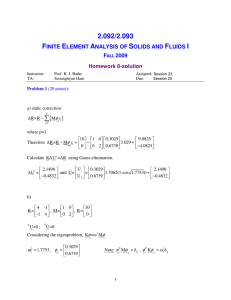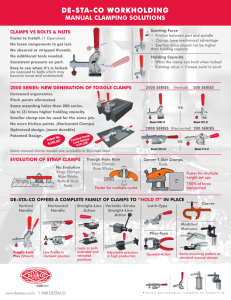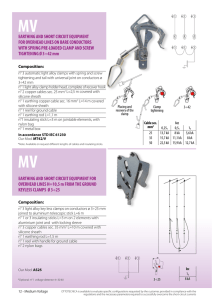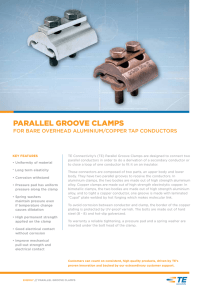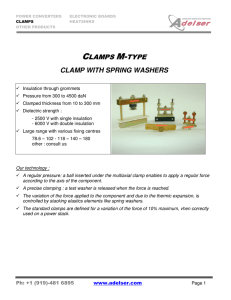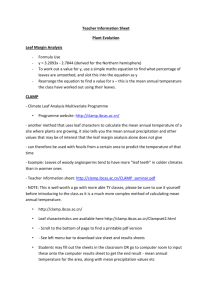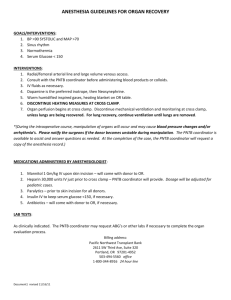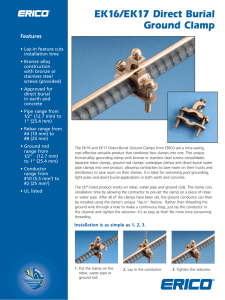Document 13486020
advertisement
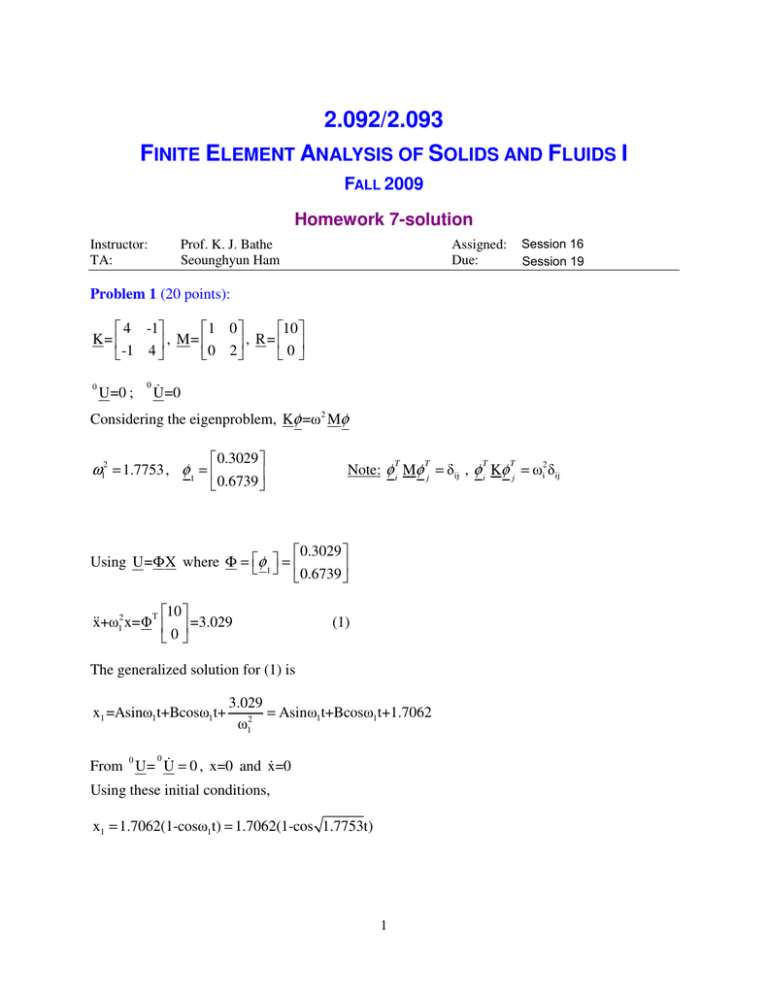
2.092/2.093 FINITE ELEMENT ANALYSIS OF SOLIDS AND FLUIDS I FALL 2009 Homework 7-solution Instructor: TA: Prof. K. J. Bathe Seounghyun Ham Session 16 Session 19 Assigned: Due: Problem 1 (20 points): ⎡ 4 -1⎤ ⎡1 0 ⎤ ⎡10 ⎤ K= ⎢ , M= ⎢ , R= ⎢ ⎥ ⎥ ⎥ ⎣-1 4 ⎦ ⎣0 2 ⎦ ⎣0⎦ 0 U=0 ; 0 � U=0 Considering the eigenproblem, Kφ =ω2 Mφ ⎡ 0.3029 ⎤ ⎥ ⎣ 0.6739 ⎦ ω12 = 1.7753 , φ 1 = ⎢ T T ⎡0.3029 ⎤ Using U=ΦX where Φ = ⎡⎣φ 1 ⎤⎦ = ⎢ ⎥ ⎣0.6739 ⎦ T ⎡10 ⎤ �� x+ω12 x= Φ ⎢ ⎥ =3.029 ⎣0⎦ (1) The generalized solution for (1) is x1 =Asinω1t+Bcosω1t+ T T Note: φ i Mφ j = δij , φ i Kφ j = ωi2 δij 3.029 = Asinω1t+Bcosω1t+1.7062 ω12 0 0 � = 0 , x=0 and x� =0 From U= U Using these initial conditions, x1 = 1.7062(1-cosω1t) = 1.7062(1-cos 1.7753t) 1 ⎡0.5168(1-cos 1.7753t) ⎤ ⎡ 0.3029 ⎤ Therefore, U= Φ X = ⎢ 1.7062(1-cos 1.7753t)= ⎢ ⎥ ⎥ ⎣ 0.6739 ⎦ ⎣⎢1.1498(1-cos 1.7753t) ⎥⎦ Problem 2 (10 points): For case 1, the structure is clearly unstable, hence a zero diagonal element will be encountered in the Gauss elimination. u3 u2 u1 u4 u6 u5 All clamps see stiffness. No rigid body motion possible. After removing the clamp at u1, u3 u2 u6 u4 u5 All clamps see stiffness. No rigid body motion possible. 2 After removing the clamp at u2, u3 u6 u4 u5 All clamps see stiffness. No rigid body motion possible. After removing the clamp at u3, u6 u4 u5 The clamp for u5 “sees” no more stiffness. A rigid body rotation is possible. Therefore there will be a zero diagonal term after the third step of Gauss elimination. For case 2, the structure is clearly stable, hence there will be no zero diagonal term in the Gauss elimination. Problem 3 (10 points): �� 2U+8U=0 0 (1) � U=10-12 , 0 U=0 (2) 3 K = 4=2 M ω2 = Therefore ω = 2 and Δtcr = T π = 2 ω = 1. Δt = 1.01×1 = 1.01 �� using eq. (1) and (2) We are able to obtain 0 U 0 �� - 4 0 U= - 4×10-12 U= To calculate -Δt U , use (9.7) in textbook, 2 -Δt � Δt 0 U �� U= 0 U - Δt 0 U+ 2 1.012 (−4×10−12 ) = −1.0402 ×10 −12 =10−12 + 2 Then t+Δt t+Δt U can be solved using the central difference method. U=(2 - 4Δt 2 ) t U - ⎡ t+Δt U ⎤ ⎡ 2 - 4Δt 2 ⎢ t ⎥=⎢ ⎣ U ⎦ ⎣ 1 t+Δt t-Δt U −1⎤ ⎡ t U ⎤ ⎥⎢ ⎥ 0 ⎦ ⎣ t-Δt U ⎦ U becomes larger than 1030 after 345 time steps ( I used Matlab). After 345 time steps ⎡ t+Δt U ⎤ ⎡ 1.4630 ×1030 ⎤ ⎢ t ⎥=⎢ 30 ⎥ ⎣ U ⎦ ⎣ −1.9408 × 10 ⎦ Problem 4 (10 points): Step 1 Let a technician put an external force, R2=1 and then measure the corresponding displacements, u1, u2, u3, and u4. 4 R2=1 u1 u2 u3 u4 Step 2 Place clamps at u2, u3, and u4 and then impose displacements measured in step 1 and measure the forces in the clamp. R2=1 R3=0 R4=0 u2 u3 u4 Step 3 Place clamps at u3, and u4 and then impose displacements measured in step 1 and measure the forces in the clamp. R3= 8 7 u3 R4= − 5 14 u4 Step 4 Place clamps at u4 and then impose displacements measured in step 1 and measure the forces in the clamp. R4= u4 (Figures could be smaller to make it one half a page) 5 7 6 MIT OpenCourseWare http://ocw.mit.edu 2.092 / 2.093 Finite Element Analysis of Solids and Fluids I Fall 2009 For information about citing these materials or our Terms of Use, visit: http://ocw.mit.edu/terms.
